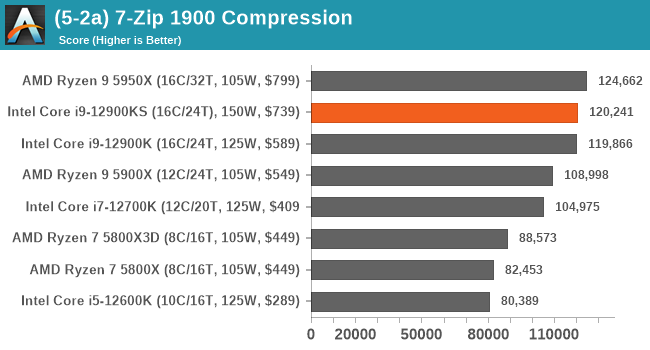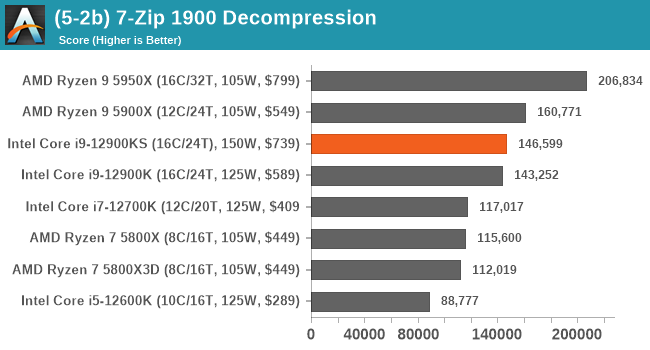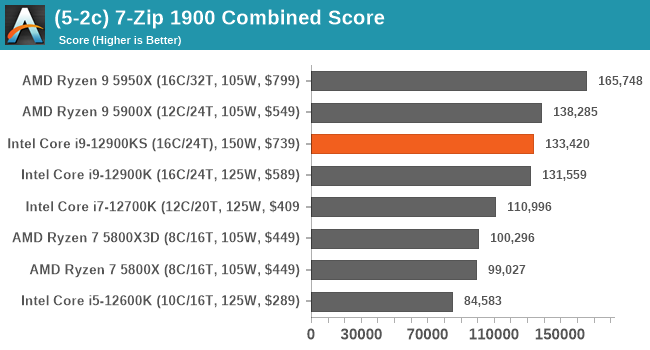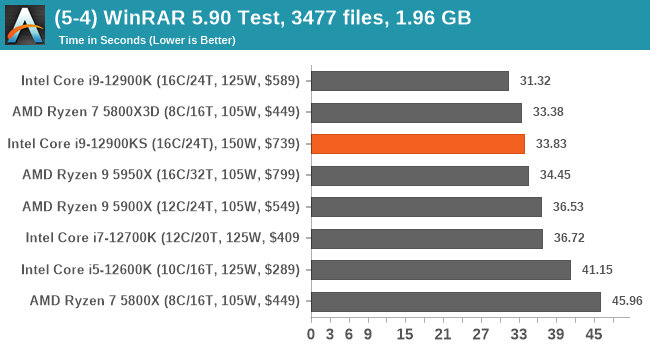The Intel Core i9-12900KS Review: The Best of Intel's Alder Lake, and the Hottest
by Gavin Bonshor on July 29, 2022 8:00 AM ESTCPU Benchmark Performance: Encoding and Compression
One of the interesting elements on modern processors is encoding performance. This covers two main areas: encryption/decryption for secure data transfer, and video transcoding from one video format to another.
In the encrypt/decrypt scenario, how data is transferred and by what mechanism is pertinent to on-the-fly encryption of sensitive data - a process by which more modern devices are leaning to for software security.
Video transcoding as a tool to adjust the quality, file size and resolution of a video file has boomed in recent years, such as providing the optimum video for devices before consumption, or for game streamers who are wanting to upload the output from their video camera in real-time. As we move into live 3D video, this task will only get more strenuous, and it turns out that the performance of certain algorithms is a function of the input/output of the content.
We are using DDR5 memory at the following settings:
- DDR5-4800(B) CL40
Encoding







In the Encoding and Compression section of our CPU benchmark suite, the Core i9-12900KS was either around the same or performed slightly better than the Core i9-12900K. The Core i9-12900KS was also consistently better than the AMD Ryzen 7 5800X3D in all encoding tests except in our WinRAR 5.90 benchmark.










56 Comments
View All Comments
fazalmajid - Friday, July 29, 2022 - link
Meh. What I want is a HEDT CPU with only P-cores, and AVX-512 re-enabled as a result. Perhaps Sapphire Rapids will deliver that.nandnandnand - Friday, July 29, 2022 - link
Fishhawk Falls, Q4 launch maybe.https://www.notebookcheck.net/16-cores-32-threads-...
https://wccftech.com/intel-hedt-sapphire-rapids-w7...
Silver5urfer - Friday, July 29, 2022 - link
HEDT is dead.Intel won't release an X299 successor. Their new Sapphire Rapids based HEDT is W, Workstation class. Meaning Prosumer just like Threadripper Pro. So expect a super high premium asking price.
Gaming and Mobile industry killed HEDT. Nowadays most of them spend more time on their junk Smartphone consuming all the stupid Social media drama and etc. So PC users are only relegated to those so called "Gaming" which is mostly - Fortnite, Pubg, COD Warzone, Apex Legends. All this garbage. Not SP games. And Windows 11 direction is also more geared towards mobile UI.
All in all HEDT is essentially gone.
brucethemoose - Friday, July 29, 2022 - link
I disagree, as I think the core count wars killed HEDT.No game I know of (other than one beta MMO) can fully saturate a top end consumer CPU these days. And most workloads will get done *reasonably* quickly on a 12900KS or 5950X.
You need more? Well thats what the P/W series is for. There's a lot of fixed-cost overhead designing something like X299 or TR4, and I don't think the volume justifies it over just making some workstationy motherboards/CPUs on a heavily amortized server socket.
StevoLincolnite - Friday, July 29, 2022 - link
My old 3930K from over 10 years ago is still playing the latest and greatest games just fine. Overclocks like a champ too.Running Ryzen 9 at the moment with 64GB of Ram.
But Quad Channel+6 Core/12 threads is what gave it that longevity because it's a HEDT platform.
Fast forward to today... They essentially just moved HEDT chips onto consumer platforms and dialed up the core counts... Which is why the price points of high-end Ryzen 9 can align itself to older HEDT chip price brackets of old.
There just isn't a dedicated socket for it anymore... Or Quad channel memory.
michael2k - Saturday, July 30, 2022 - link
I don’t think it’s possible to make a CPU faster anymore until Intel gets to 4nm; it just takes too much power.So their only choice is wider and more cores. Apple is a node ahead and will probably hit 3nm next year when Intel hits 4nm.
StevoLincolnite - Sunday, July 31, 2022 - link
Keep in mind that nodes are not directly comparable based upon pure marketing nomenclature.Intel 7nm for example is absolutely superior to TSMC or Samsung 7nm in actual feature sizes.
michael2k - Sunday, July 31, 2022 - link
Yes you are correct but also irrelevant. Intel 7 may be superior to TSMC 7 but inferior to TSMC 5 or TSMC 5PZoolook - Monday, August 1, 2022 - link
I guess you mean Intel 7, which is their renamed 10nm, and it's debatable, Intel 7 never reached their initial proposed logical density and in comparisons of chips they seem to have less than 10% lead in density and their volume production launched years after TSMC and it's clearly worse in power efficiency.TSMC is gearing up volume production on N3 which is a year ahead of Intels comparable (projected density) Intel 4 process.
michael2k - Saturday, July 30, 2022 - link
It’s funny how Apple still has a ‘jest’ CPU; 16 pcores and 4 ecores in the M1 Ultra.But AMD still sells a 16 core part too:
https://nanoreview.net/en/cpu-compare/apple-m1-ult...
https://www.amd.com/en/products/cpu/amd-ryzen-9-59...
The real question is if core counts will go up with the M2 Ultra; adding 2 p cores to the M2 Max (10/2) would give the M2 Ultra 20/4
The problem Intel and AMD have is that their power draw is so high it gets hard to add more cores and still cool the part.